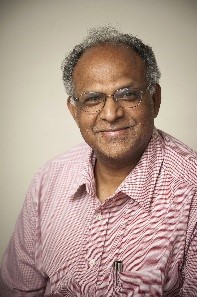 Organization/Department
Organization/Department
University of Leeds
Professor of Materials Science
Biography
Professor Animesh Jha is a full-time professor of materials science at the University of Leeds. His main research interests is in the areas of Photonic Materials and Devices and Light-Matter Interaction and applications of such processes in device engineering. The above topic manifests AJ’s interest which he has taken forward for exploring a range of application in collaboration with two established laboratories in India.
AJ obtained his BE (Metallurgy) in 1979 (University of Roorkee, India), ME (Metallurgical Engineering) in 1981 from the Indian Institute of Science Bangalore (India), and PhD and DIC from Imperial College London in 1984.
Title of Talk
Morphological Engineering of Bio-Minerals Using Near-IR Mode-locked Lasers – a new approach for integrative manufacturing of hard-soft tissues for in-theatre use!
A Anastasiou1, E Al-Shubhe1, N Iqbal1, T Edwards2, C T A Brown2, C. Amorese3, S Strafford4, E M Raif4, M S Duggal5, D. Bikaris7 P.V Giannoudis8, and Animesh Jha*,1
1: School of Chemical & Process Engineering, University of Leeds, Leeds LS2 9JT (UK).
2: School of Physics & Astronomy, University of St Andrews, North Haugh, St Andrews KY16 9SS (UK).
3: I.C.M.E.A. SRL, Via Mongelli 11 – 70033 Corato (Bari) Italy
4: Division of Oral Biology, School of Dentistry, University of Leeds, Leeds LS2 9JT (UK).
5: School of Dentistry, The National University of Singapore, Singapore
6: Laboratory of Polymer Chemistry and Technology, Chemistry Department, Aristotle University of Thessaloniki, 54124 Thessaloniki, Greece
7: Leeds Institute of Rheumatic and Musculoskeletal Medicine, University of Leeds, Leeds LS2 9JT (UK).
*,1: contact and presenting author: a.jha@leeds.ac.uk
Abstract
The emergence of mode-locked near-IR (NIR 800-1550 nm) lasers has opened novel and exciting opportunities in dental and orthopaedic medicine. In a mode-locked laser cavity, the pulse duration and repetition rates may be controlled between 10 and 100s of femtosecond (fs) and kHz and GHz ranges, respectively. This unique capability for controlling the incident laser power in an NIR mode-locked laser has been explored for studying the phase transformation and structural changes in bio-minerals and chitosan-calcium mineral composites, and sintering and bonding mechanisms in situ with the vicinal calcium phosphate. In the proposed tissue engineering approach, we primarily focus on interaction of such near-IR lasers in a linear (resonant) regime for analysing the evolution of densification in minerals and the mechanism of porosity generation, which may be required for physiological and anatomical functions of tissues in vivo when implanted to substitute or restore a damaged tissue region.
Examples of structural evolution of bio-mineral structures as a result of the phase transformation, using mode-locked 1040 nm lasers will be presented.
In this invited talk, we will discuss the materials fabrication, parameters for safe laser-bio materials interaction, and laser power delivery system for restoring the damaged surfaces of eroded enamel and periodontal tissues; the latter represents a hard-soft tissue interface. The materials engineered and processed are tested in vitro for cellular and genetic toxicology responses. The integration approach for medical device engineering for combining the materials delivery system with mode-locked lasers is specially emphasized for safety in clinical practice. For first dental pre-clinical trials, the proposal for progressing in situ mouth appliance trials is also discussed before considering first-in-human trials.
Acknowledgements: The authors of this project acknowledge the financial support from the EU-H2020 and FP7 programmes for projects: EU-H2020 BonE-GraphT-75229; EU-H2020 PreFaCTO 660147; EU-FP7 Marie-Curie IAPP; EPSRC LUMIN (EP/K020234/1); and Innovate UK (TS/S002022/1,9372).
